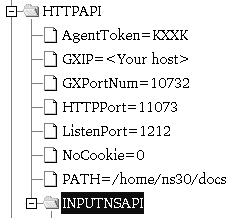Open the registry editor by typing kregedit at the command prompt.
The registry editor opens and displays the keys and values that apply to the
Netscape Application Server. If the web server and Netscape Application
Server are installed on separate machines, the registry editor opens and
displays the keys and values that apply to the web connector plug-in.
For Windows NT, use regedit and start at
HKEY_LOCAL_MACHINE\\SOFTWARE\\KIVA.
For Netscape web servers, open the following key:
KIVA\\Enterprise\\2.0\\HTTPAPI\\INPUTNSAPI

For Microsoft web servers, open the following key:
KIVA\\Enterprise\\2.0\\HTTPAPI\\INPUTISAPI
Each value under these folders represents an HTTP variable and whether it
is being passed to the Netscape Application Server along with the
application request. If the value is non-zero, that variable is passed to the
Netscape Application Server with the application request.
The HTTP variable is in ALL CAPS, such as HTTP_REFERER.
Add a new String value with the new HTTP variable name.
Double-click the new HTTP variable and enter the one of the following as the value data:
Click OK.
Repeat steps 4 through 6 for each new HTTP variable.
When finished, close the registry editor.